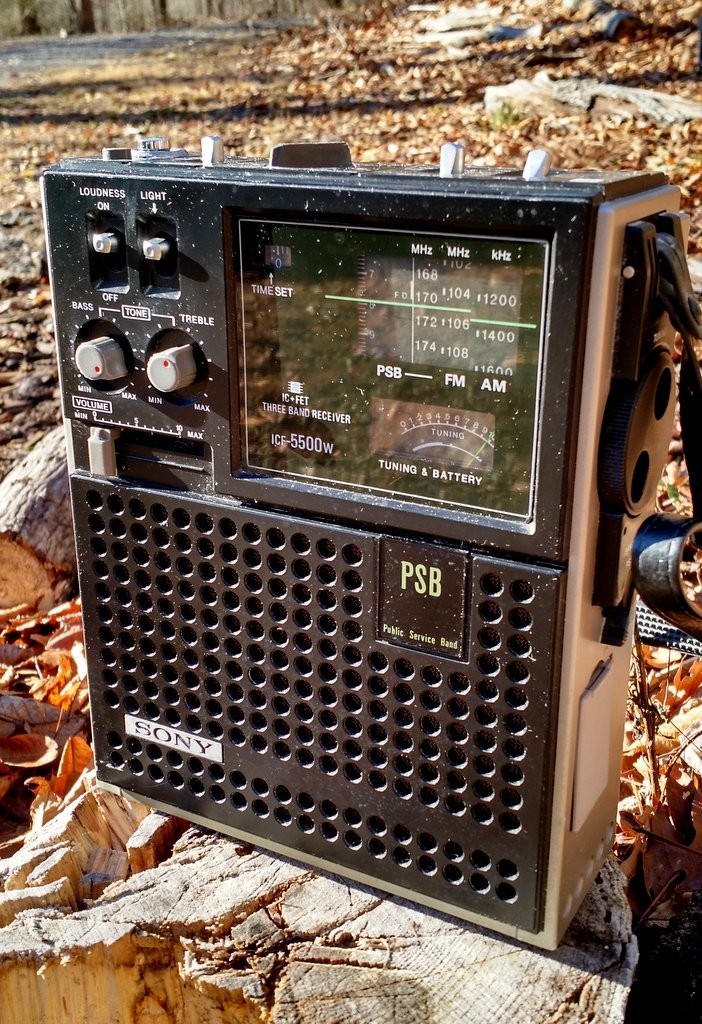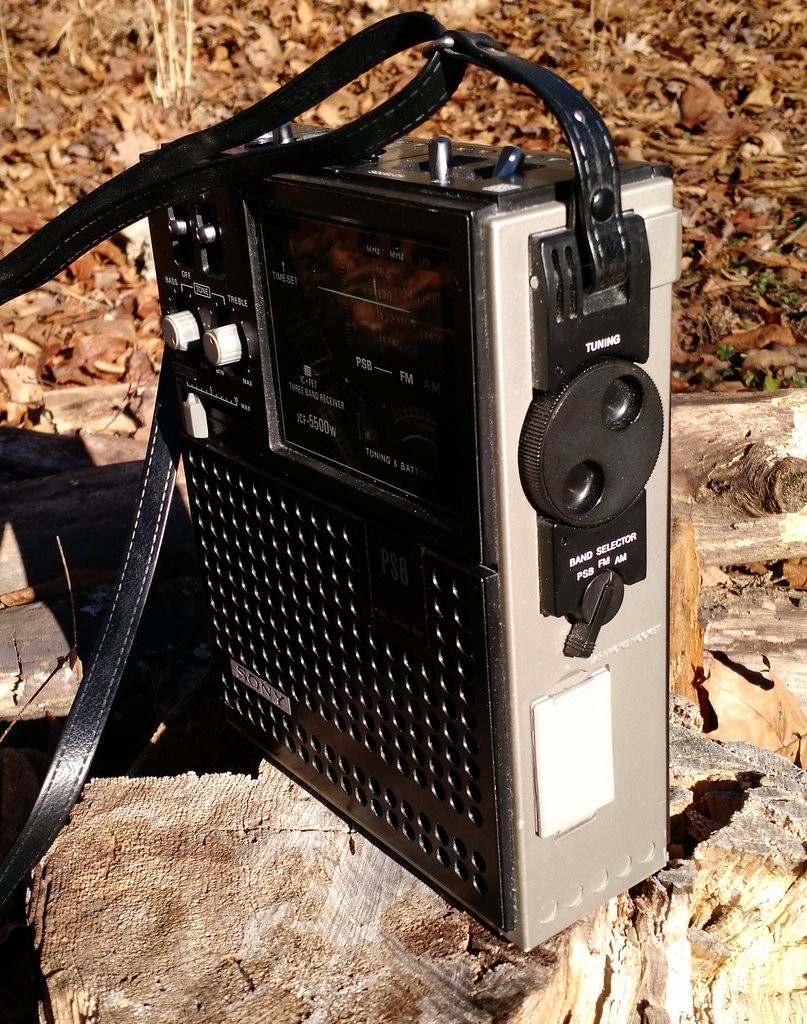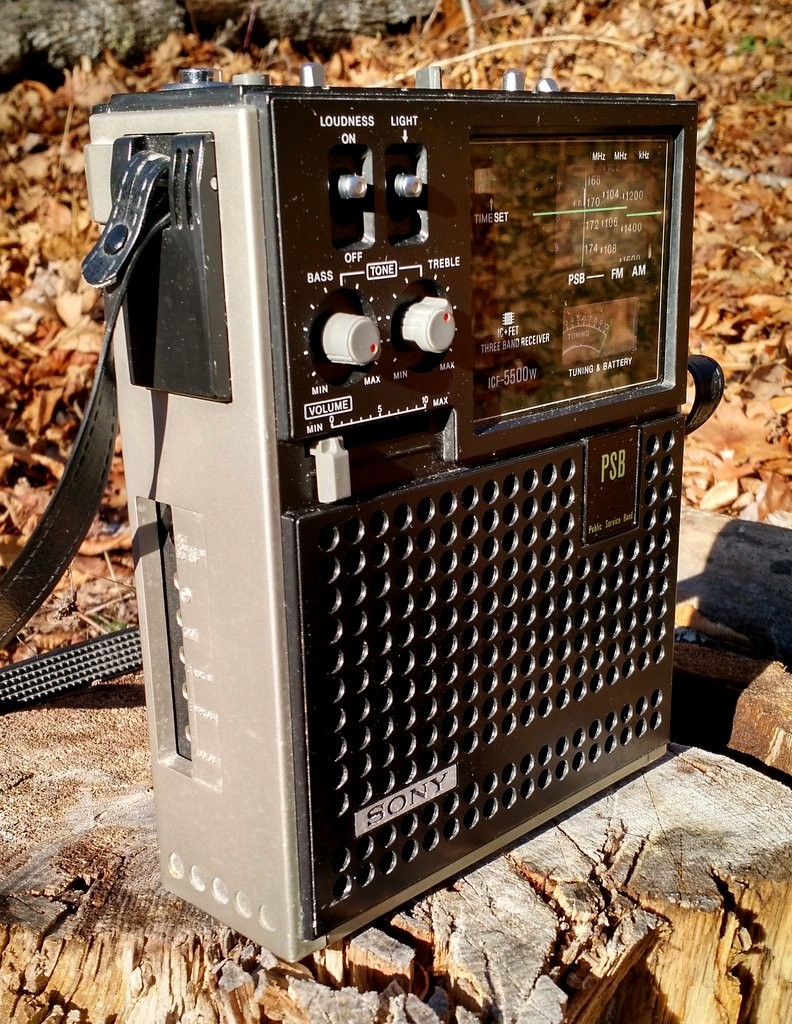 Friday, I brought home an untested, slightly grimy, Sony ICF-5500W. I purchased it through Goodwill for $20.
Friday, I brought home an untested, slightly grimy, Sony ICF-5500W. I purchased it through Goodwill for $20.
I crossed my fingers as I put three C cells in the radio and turned it on. Fortunately, I was rewarded with brilliant audio. I tuned the ‘5500W on AM/mediumwave and heard CFZM, 500 miles to my north, and Radio Reloj, 860 miles to my south. A quick scan on the FM dial revealed that I could also hear all of my local benchmarks. Whew!
Other than the dial needing a little calibration, and DeOxit on a few pots, it’s in excellent mechanical shape.
I started cleaning the radio last night using Q-tip cotton swabs and a vinegar/water solution.
I’d like to restore the hard plastic chassis’ original shine, though.
I was tempted to reach for some Armor All, but stopped myself short. I know it would give the ICF-5500W a nice shine, but would it cause any long-term damage to the black plastic or clear dial cover?
I know there are vintage radio restorers among the SWLing Post readership. Can someone offer advice on what’s the best product to use (or not use!) on my ICF-5500W?
If you have experience, please comment!



I still have it in working order. Only it is a pity that shortwave and medium wave stations have nearly all shut down. FM works very well.
Formula 409 on the plastic, everywhere but the clear plastic…there, for the scratches, use cigarette ash. rub it in gently.
I too have an ICF-5500M which works very well. I clean it with a combination of cotton buds and a soft toothbrush and a very sparing amount of mild non-foaming detergent, normally a kitchen/bathroom type cleaner. It’s the only way to cut through the grease, unless you use vinegar which is smelly.
I have another question, being illiterate electronically. I have used batteries so far, as I haven’t a power cord. How do I find a replacement power cord? I’ve searched on line but find no clear recommendations.
Hi Thomas, here’s yet another suggestion for detailing your fine Sony ICF-5500W: Rubber & Vinyl Dressing from the automotive accessories firm Griot’s Garage.
http://www.griotsgarage.com/product/vinyl+rubber+dressing.do?sortby=ourPicks&refType=&from=Search
This company’s products are used by top automotive collectors and restorers, such as those who exhibit at the prestigious Pebble Beach concours. I’ve read in a couple places on the Web that vintage radio enthusiasts like this product, which also works well on hard plastic surfaces such as radio cases. I use this on my own receivers and I think it’s great.
By the way, I live a 30-minute drive from the Griot’s Garage headquarters, and the “back room” is a mini car museum, with different vehicles (esp. vintage race cars) displayed on a regular rotation. For example: http://www.griotsgarage.com/text/content/prodinfo/videos/html/griots_treasures_3.html
Thomas,
What a beautiful radio, congratulations on getting this nice example of a 70’s era radio. Not sure about what liquid cleaners to use, but a can of dust spray, Q-Tips, a soft bristle toothbrush, miscellaneous small artist brushes, toothpicks and pipe cleaners (for smoking pipes that is hi hi) will help to get the dirt/dust out of the outside nooks and crannies. The tooth brush is at the right angle for cleaning the crevices on the knobs if you don’t want to remove them. Have fun with your new radio Thomas.
Mario
Hi,
I’ve got good results with wd40. Beware not to rub labels off. And first of all, remove all dust with a clean rug, or compressed air.
73
Guido, LU8EQ
This brings back many memories – the Captain 55 was only my second shortwave radio (paid for from earnings from my first job), and I remember too that the audio was very good on this set. The UK version was sold with shortwave coverage from the 120mb down to the 25mb, though missing out on the 19mb.
I love my Captian 55. Sits right by the bedside.
Some very good suggestions here. I have also done cosmetic restoration on plastics found on a number of products from vintage wooden boats to boat anchor radios and portable radios. Meguiars PlastX is good for restoring gloss and clarity to dulled, damaged plastics.
Another auto product is my go-to cleaner and protectant for all plastics: Blue Coral High Foam Car Wash Concentrate is my favorite for the boat and cars but I have used it for many years to detail plastic radios and other equipment. Use it at half the automotive paint strength for plastics of all kind. It will bead surface water. It leaves a natural gloss, not overglossy or slippery like Armor All. Safe for all plastics, glass, metals and paints. Good for maintaining new radios, too. Use only 100% cotton rags for cleaning plastics. Cotton terry cloth and Q-tips are great for reaching nooks and crannies on radio exteriors. So are small natural (usually pig) bristle paint brushes. Synthetic cloth can damage plastics. If you have paint splatters on the radio these can be removed carefully by mechanical means, especially if it is latex house paint. Oil based enamels may be a more stubborn matter.
Nice find on the 5500!
I’ve come to swear by Mothers Back-to-Black from the auto store for restoring the finish to older transistor sets. It seems to last longer then Armour All, and despite it’s name works fine on the clear plastic too. Knobs that have accumulated finger grime I remove and let soak in water and Dawn, then use a toothbrush to reach into ridged areas, dry well and then finish with Black to Black.
Once I have a set clean, I fashion a clear plastic cover out of document protectors to stop the accumulation of household dust, which can be a hassle with some radios with lots of buttons like the ICF-2010.
I actually cleaned up a similar model, the 5500M (which has SW rather than public service band). I just took off the case, nobs, switches and gave them a bath with liquid laundry detergent (they have brand names like fluffy or softly). This detergent will lift off the dust & grime without the need for scrubbing. One word of caution, don’t use hot water, only lukewarm, otherwise it may change/fade the colour of the plastic!
Yes I disassemble a whole radio aswell.The older type I find are alot easier to do that than the newer ones that are have everything squeezed in together.I take everything apart,Unplugging wires etc,making a diagram of where everything goes back.Then the cleaning starts to get all the dust and grim thats built up over the years out of it.I soak the plastic chassis or case in warm soapy water to soften anything,then useing an old tooth brush scrub it all.Knobs and switch levers the same.I dont get any mosture on the circuit boards.I then use clean small paint brushes and a small hand held vacuum cleaner to suck and clean the boards as best as I can,then once everything is dry,I reassemble.As far as marks and scratches go,yes I would agree that cigarette ash would be the best.But with the radio showing a few scratches,it shows that its had a life somewhere,so I wouldnt be too much of a perfectionist as it adds to its mileage,just like an old car showing its age and wear and tear.But I have a passion for these old ones.Sometimes there’s only so much you can do depending on its condition.Some I’ve found even in rubbish tips have been really abused but managed to get them going again.Some are way beyond repair and its a real shame,as you just dont see them again.Anyway have lots of fun and satisfaction!!
Don’t use acetone,denatured alcohol on cabinets, I would use armor-all on vinyl straps. For plastic, I use the same stuff used for cleaning up fogged plastic headlight lenses on cars. You can get it in auto parts stores. What I generally do is disassemble the whole radio and wash the plastic cabinet in warm water and dish washing liquid. Some times the plastic posts the pcb are mounted on may be cracked/stripped. fill them with epoxy and re drill and thread with the screws. If whole sections are missing sometimes you can make a mold with tape and replicate by filling in with epoxy or bondo. If you are ambitious, you can clean off the flux on the pcb then spray with clear krylon once you know it works
Oh, and I forgot to mention, that the product called Fantastic! makes a really good initial cleaner for the initial cleaning. A bottle will last for years.
The Armour All works fine. I prefer the nonglossy, as it is glossy enough!
For the clear plastic over the dials, what I have found takes out the scratches like magic is a fine cloth, and….Cigarette ashes! Get some cigarette ashes from a smoker friend. Or just buy some and let them burn down. But it’s easier to find a smoker friend to help you with this. And you don’t want any tobacco or filtre remnants, JUST cigarette ashes. Gently rub them on the clear plastic, dry. It takes the scratches right out! It works on watch dials, too.
Lock Ease (brand) works good on the whip antennas. NEVER use any of that silicone stuff on the antenna whips…it ends up INSULATING the individual elements and you don’t want that to happen !
I meant “soap” in previous comment
Was going to ask “What flavor of soup is best?”
Warm water with soup is very good for knobs and chassis and other things that you can easily open and take apart.
Don’t forget Ethanol too (for cleaning dirt and germ on things that can’t be opened and washed)
Also read this very good post: http://mrmodemhead.com/blog/dirty-multimeter-clean-up/
I also recently opened my old devices (a signal generator and a frequency meter) and washed them 🙂
After washing plastic parts, let them dry (don’t expose plastic parts to very hot air for drying.)
As others have said, soft tissues and soft brush is also necessary.
might research some pinball forums, i think they like Novus products. (Pinballs have many plastic parts)
From what I’ve read on Antique Radio Forms, Novus Plastic Polish is the answer. I haven’t used it, but I’ve been researching the same issue for something to use cleaning up a GE P780 and the face plate of a Kenwood R-1000. I tried a little Simichrome polish on the R-1000 but stopped after seeing (what I thought was) too much color on the rag. Another thought is toothpaste. It’ll be interesting to see what others have to say. Good luck with your project!